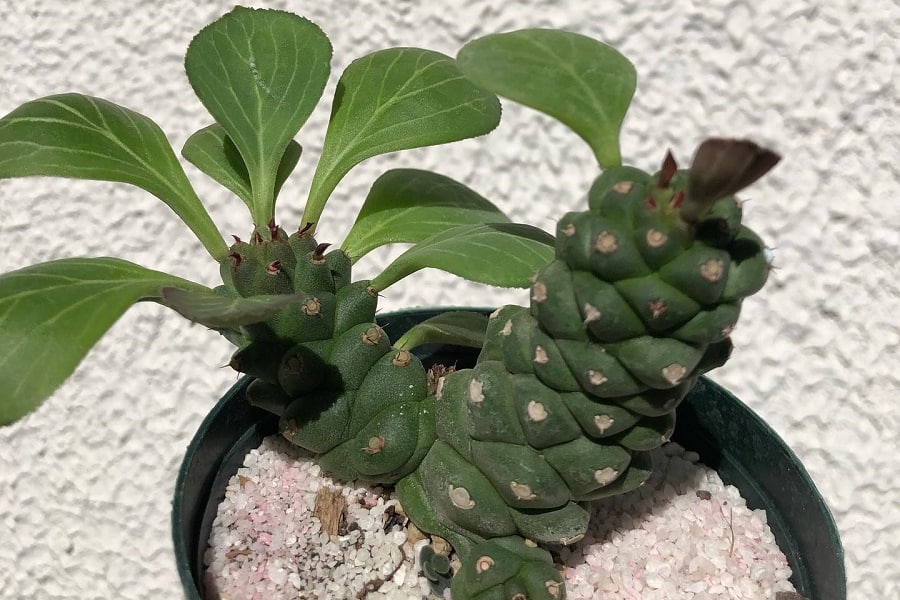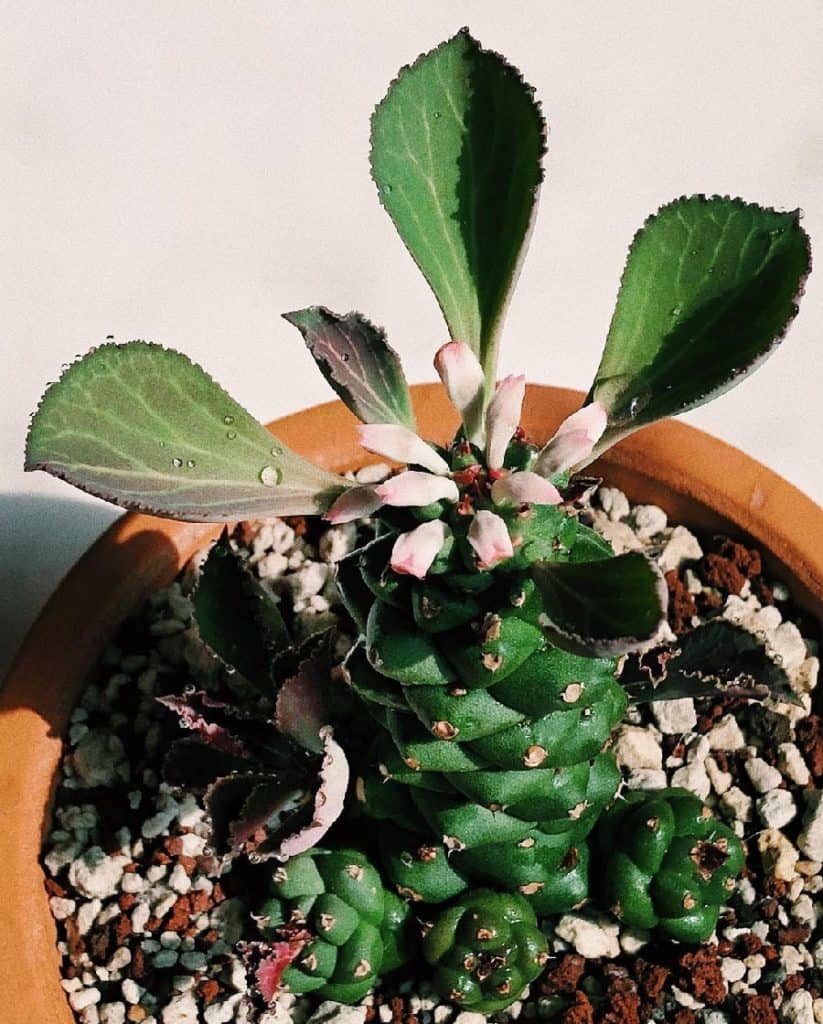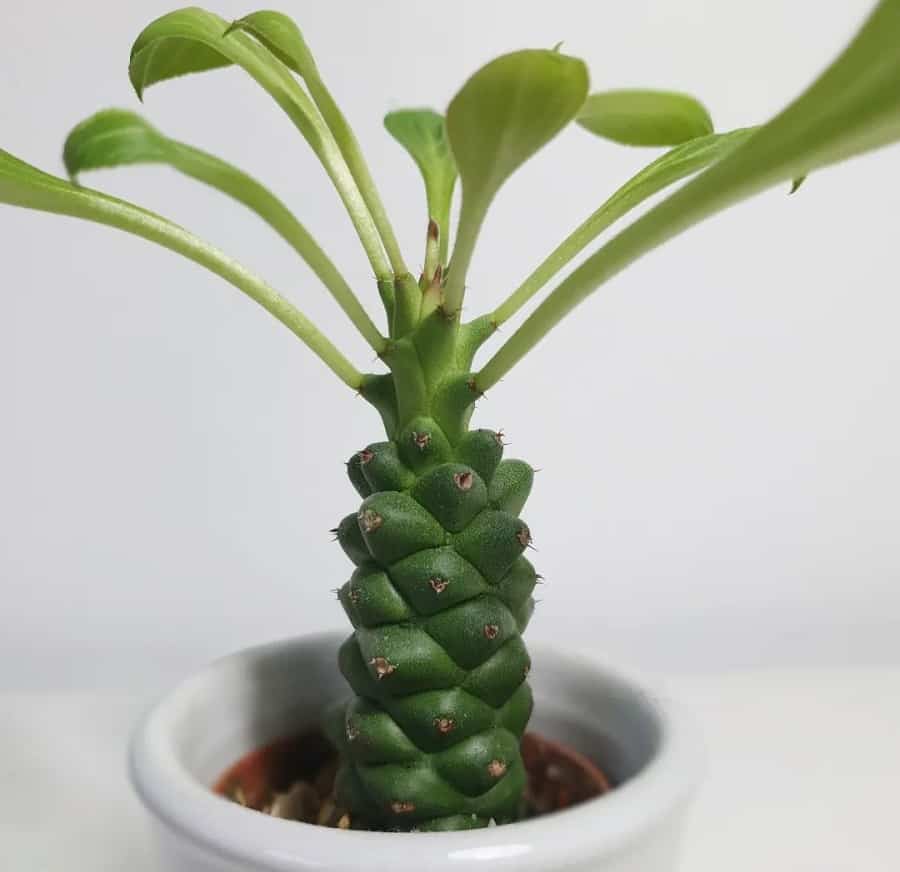Euphorbia ritchiei: Characteristics and Care
Are you tired of the same old houseplants? Bored with the basic ficus and ready for something truly extraordinary? Meet Euphorbia ritchiei, the succulent sensation taking the plant world by storm. With its striking appearance and easy-care nature, this Kenyan native is about to become your new obsession. Keep reading to discover why Euphorbia ritchiei is the must-have plant of the year!

Contents
About Euphorbia ritchiei
Euphorbia ritchiei is a succulent from Kenya with thick, fleshy green stems that can grow up to 2 feet tall. It produces numerous offsets, making it a breeze to propagate. The stems are covered in tiny spines, but don’t worry – they’re not sharp enough to cause any real harm.
The real showstopper of this plant is its cyathia or ‘false flowers.’ These bright pink structures create a striking contrast against the vivid green, circular leaves. While Euphorbia ritchiei may seem a little fussy when young, with the right care, it’s a total superstar.
Related Post:
200 Types of Euphorbia With Pictures
Euphorbia ritchiei Care Tips
Light
Euphorbia ritchiei thrives in full sun, needing at least 6 hours of direct sunlight per day. Outdoor plants may need some afternoon shade in areas with intense sunlight to prevent burning or yellowing. Indoor plants should be placed near a south-facing window for maximum light exposure. If natural light is limited, invest in a quality grow light designed for succulents.
Water
From spring to fall, when Euphorbia ritchiei (Monadenium ritchiei) is actively growing, water the plant whenever the top 2 inches of soil become dry. This succulent is quite drought-tolerant, so watering about once a week is usually sufficient. Morning is the ideal time to water, allowing the plant to soak up moisture before the heat of the day.
During the winter dormancy period, reduce watering to only when the plant shows signs of wilting. Even if the soil feels crispy, don’t let more than a month pass without some water.

Soil
Euphorbia ritchiei is a succulent, so it needs very well-draining soil. Make your own mix by combining equal parts regular potting soil and coarse sand or perlite. You can also use a commercially available cactus/succulent potting mix straight out of the bag.
Fertilizer
During the growing season from spring to fall, feed your Euphorbia ritchiei with a balanced liquid fertilizer diluted to half strength every 4-6 weeks. Container plants will need more frequent feeding. Watch for yellowing lower leaves, which indicates a need for fertilizer. Avoid fertilizing in winter when the plant is dormant.
Climate
These low-maintenance plants adapt to a wide range of climates. Ideal temperatures are 70-80°F during the day and 55-65°F at night. Maintain humidity around 50% if possible, but Euphorbia ritchiei can tolerate dry indoor air quite well.
Pests and Diseases
The biggest pests to watch for are spider mites and mealybugs, which can quickly infest the plant if left unchecked. Regularly inspect your plant and treat any pests promptly with an insecticidal soap or neem oil spray.

Pruning
Pruning isn’t required for Euphorbia ritchiei, but you can trim off dead or damaged stems as needed to keep it looking tidy. Always use clean, sharp pruners and cut stems back to just above a leaf node.
Repotting
Repot Euphorbia ritchiei every 2-3 years in early spring before new growth emerges. Choose a container only 1-2 inches wider than the previous one with ample drainage holes. Gently remove the rootball and replant in fresh succulent soil.
Euphorbia ritchiei Propagation Guide
Euphorbia ritchiei can be easily propagated from either stem cuttings or seeds.
Stem Cutting Propagation
This is the faster and more straightforward propagation method for this succulent. Here are the steps:
- Using a clean, sharp knife or pruners, take 4-6 inch stem cuttings from a healthy Euphorbia ritchiei plant. Cut just below a leaf node.
- Allow the stem cuttings to callus over for 2-3 days before planting. This helps prevent rotting.
- Fill a shallow tray or pot with well-draining cactus/succulent potting mix.
- Plant the calloused cuttings vertically, burying about 1-2 inches of the stem into the soil. Space multiple cuttings a few inches apart.
- Water sparingly, just enough to settle the soil but not soak it.
- Place the cuttings in a warm (70-80°F), bright location out of direct sun.
- In 4-8 weeks, you should see new growth emerging as signs of successful rooting.
Seed Propagation
While slower, propagating from seed produces an abundance of new Euphorbia plants.
- Fill a seed tray with a mix of 50% commercial seed starter and 50% coarse sand or perlite.
- Sprinkle seeds on the surface and cover lightly with soil mix, about 1/4 inch deep.
- Water gently from the bottom to avoid displacing the seeds.
- Cover the tray with plastic wrap or a humidity dome to maintain moisture.
- Place the tray in a warm (70-80°F) spot with bright, indirect light.
- Check regularly and water from the bottom when the soil surface becomes dry.
- Be patient – germination can take 2-6 months for Euphorbia ritchiei seeds.
- Once seedlings appear, remove the cover and place in direct sun.
With either method, transplant newly rooted cuttings or seedlings into their own containers once established.
